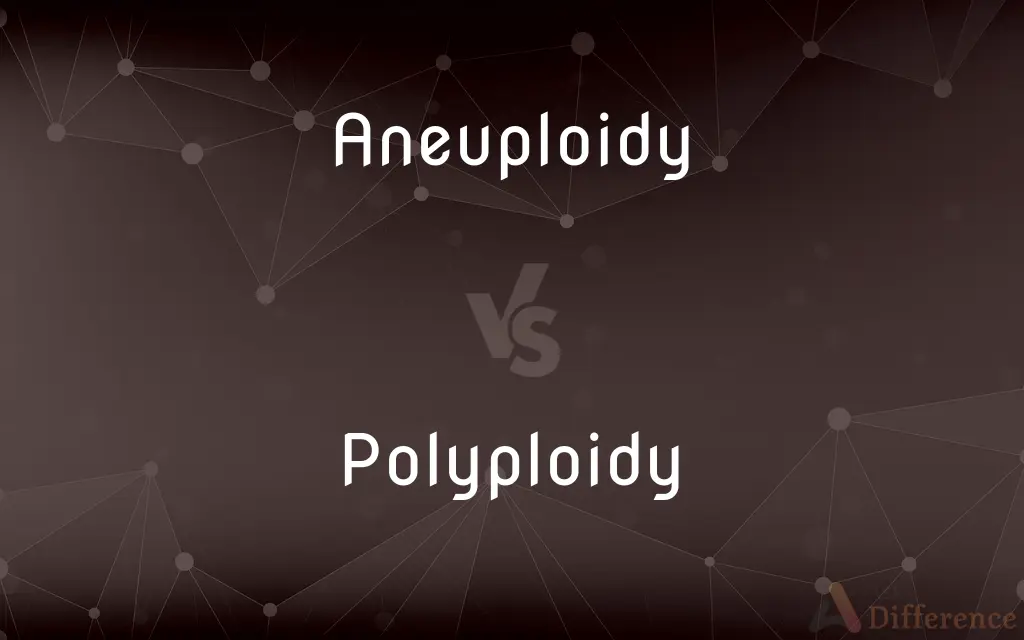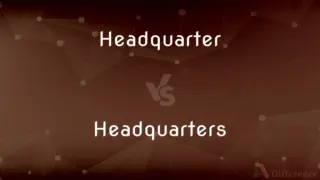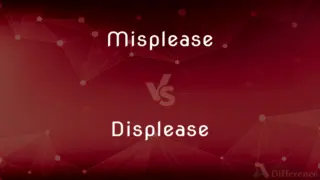Aneuploidy vs. Polyploidy — What's the Difference?
By Tayyaba Rehman & Fiza Rafique — Updated on March 19, 2024
Aneuploidy involves an abnormal number of chromosomes in a cell, usually one more or one less than the normal set. Polyploidy, however, refers to cells or organisms having more than two complete sets of chromosomes, exceeding the diploid number.

Difference Between Aneuploidy and Polyploidy
Table of Contents
ADVERTISEMENT
Key Differences
Aneuploidy results from the missegregation of chromosomes during cell division, leading to cells with an incomplete set of chromosomes, such as trisomy (three copies of one chromosome) or monosomy (a single copy of a chromosome). Polyploidy arises when an organism inherits multiple complete sets of chromosomes, often through errors in cell division or the fusion of gametes, leading to organisms with triploid, tetraploid, or higher chromosome numbers.
In humans, aneuploidy can cause genetic disorders like Down syndrome (trisomy 21), characterized by developmental and intellectual challenges. Polyploidy is rare in animals but common in plants, where it can lead to increased size, vigor, and adaptability, as seen in many crop species.
Aneuploidy can occur in any chromosome and affects individuals by altering the gene dosage, potentially disrupting normal development and function. Polyploidy, on the other hand, usually results in a more generalized increase in cell size and metabolic capacity, often conferring evolutionary advantages in plants.
The significance of aneuploidy varies among organisms; it is often detrimental in animals, leading to developmental disorders or cancer. Polyploidy in plants contributes to biodiversity and speciation, enabling adaptation to diverse environments.
The detection and study of aneuploidy are crucial in medical genetics for diagnosing chromosomal abnormalities. Polyploidy research focuses on understanding evolutionary biology and improving agricultural crop species through breeding for desirable traits.
ADVERTISEMENT
Comparison Chart
Definition
Abnormal number of chromosomes in a cell.
More than two complete sets of chromosomes.
Common In
Humans and other animals.
Plants and some lower animals.
Results From
Missegregation of chromosomes during cell division.
Errors in cell division or fusion of gametes.
Examples
Down syndrome (trisomy 21), Turner syndrome (monosomy X).
Wheat (hexaploid), some amphibians (tetraploid).
Impact
Often detrimental, leading to developmental disorders or cancer.
Can increase size, vigor, and adaptability.
Gene Dosage Effect
Alteration leads to developmental and functional disruptions.
General increase in cell size and metabolic capacity.
Significance in Evolution
Often negative, with potential for disease.
Positive, leading to biodiversity and speciation.
Research Focus
Diagnosing chromosomal abnormalities.
Evolutionary biology, agricultural improvements.
Compare with Definitions
Aneuploidy
It results from errors during cell division.
Nondisjunction in meiosis can lead to aneuploidy.
Polyploidy
It is common in plants and some animals.
The lily is a naturally occurring polyploid plant.
Aneuploidy
Aneuploidy can cause genetic disorders.
Turner syndrome is caused by having a single X chromosome.
Polyploidy
Polyploidy is important in plant breeding.
Breeders induce polyploidy in plants to develop new varieties.
Aneuploidy
It can affect any chromosome.
Trisomy 18 results in Edwards syndrome, with severe developmental issues.
Polyploidy
Polyploidy can lead to increased size and vigor.
Polyploid crops often have larger fruits and flowers.
Aneuploidy
Aneuploidy is often detected through genetic testing.
Prenatal screening can identify trisomy 21 in fetuses.
Polyploidy
It arises from cell division errors or gamete fusion.
Tetraploid frogs result from errors in mitosis.
Aneuploidy
Aneuploidy is the presence of an abnormal number of chromosomes in a cell.
Humans with Down syndrome have an extra chromosome 21.
Polyploidy
Polyploidy involves having more than two complete sets of chromosomes.
Many crop plants, like wheat, are polyploid.
Aneuploidy
Aneuploidy is the presence of an abnormal number of chromosomes in a cell, for example a human cell having 45 or 47 chromosomes instead of the usual 46. It does not include a difference of one or more complete sets of chromosomes.
Polyploidy
Polyploidy is a condition in which the cells of an organism have more than two paired (homologous) sets of chromosomes. Most species whose cells have nuclei (eukaryotes) are diploid, meaning they have two sets of chromosomes—one set inherited from each parent.
Aneuploidy
Having a chromosome number that is not a multiple of the haploid number for the species.
Polyploidy
Having one or more extra sets of chromosomes in the cell nucleus
A polyploid species.
A polyploid cell.
Aneuploidy
An aneuploid organism or cell.
Polyploidy
A polyploid organism or cell.
Aneuploidy
(genetics) The condition of being aneuploid; the state of possessing a chromosome number that is not an exact multiple of the haploid number of the organism in question.
Polyploidy
The condition of being polyploid or the process of becoming polyploid.
Aneuploidy
An abnormality involving a chromosome number that is not an exact multiple of the haploid number (one chromosome set is incomplete)
Polyploidy
An instance of being polyploid.
Polyploidy
The condition of being polyploid
Common Curiosities
What role does aneuploidy play in cancer?
Many cancers exhibit aneuploidy, which can contribute to tumor progression and resistance to therapy by altering gene dosage.
What causes aneuploidy?
Aneuploidy is caused by errors in chromosome separation during cell division, leading to cells with extra or missing chromosomes.
How does aneuploidy affect organisms?
Aneuploidy can lead to developmental disorders, diseases, and sometimes advantages in certain contexts, like cancer cells gaining growth advantages.
Can polyploidy occur in humans?
Polyploidy is lethal in humans and most animals, resulting in nonviable embryos or early developmental failure.
How does aneuploidy differ from a chromosome deletion or duplication?
Aneuploidy affects the entire chromosome number, while deletions or duplications involve segments of chromosomes, affecting fewer genes.
What is the difference between autopolyploidy and allopolyploidy?
Autopolyploidy results from the duplication of chromosomes from the same species, while allopolyploidy comes from combining chromosomes of different species.
Why is polyploidy more common in plants than in animals?
Polyploidy in plants often leads to beneficial traits like increased size and adaptability, while in animals, it can disrupt development.
Can aneuploidy be detected before birth?
Yes, prenatal screening methods can detect aneuploidy, allowing for early diagnosis of conditions like Down syndrome.
How is polyploidy beneficial to plants?
Polyploidy can confer evolutionary advantages, such as increased vigor, fertility, and adaptation to environmental stress.
Is polyploidy reversible?
Once established, polyploidy is not reversible, but polyploid organisms can evolve over time, potentially leading to new species.
Share Your Discovery

Previous Comparison
Headquarter vs. Headquarters
Next Comparison
Misplease vs. DispleaseAuthor Spotlight
Written by
Tayyaba RehmanTayyaba Rehman is a distinguished writer, currently serving as a primary contributor to askdifference.com. As a researcher in semantics and etymology, Tayyaba's passion for the complexity of languages and their distinctions has found a perfect home on the platform. Tayyaba delves into the intricacies of language, distinguishing between commonly confused words and phrases, thereby providing clarity for readers worldwide.
Co-written by
Fiza RafiqueFiza Rafique is a skilled content writer at AskDifference.com, where she meticulously refines and enhances written pieces. Drawing from her vast editorial expertise, Fiza ensures clarity, accuracy, and precision in every article. Passionate about language, she continually seeks to elevate the quality of content for readers worldwide.














































